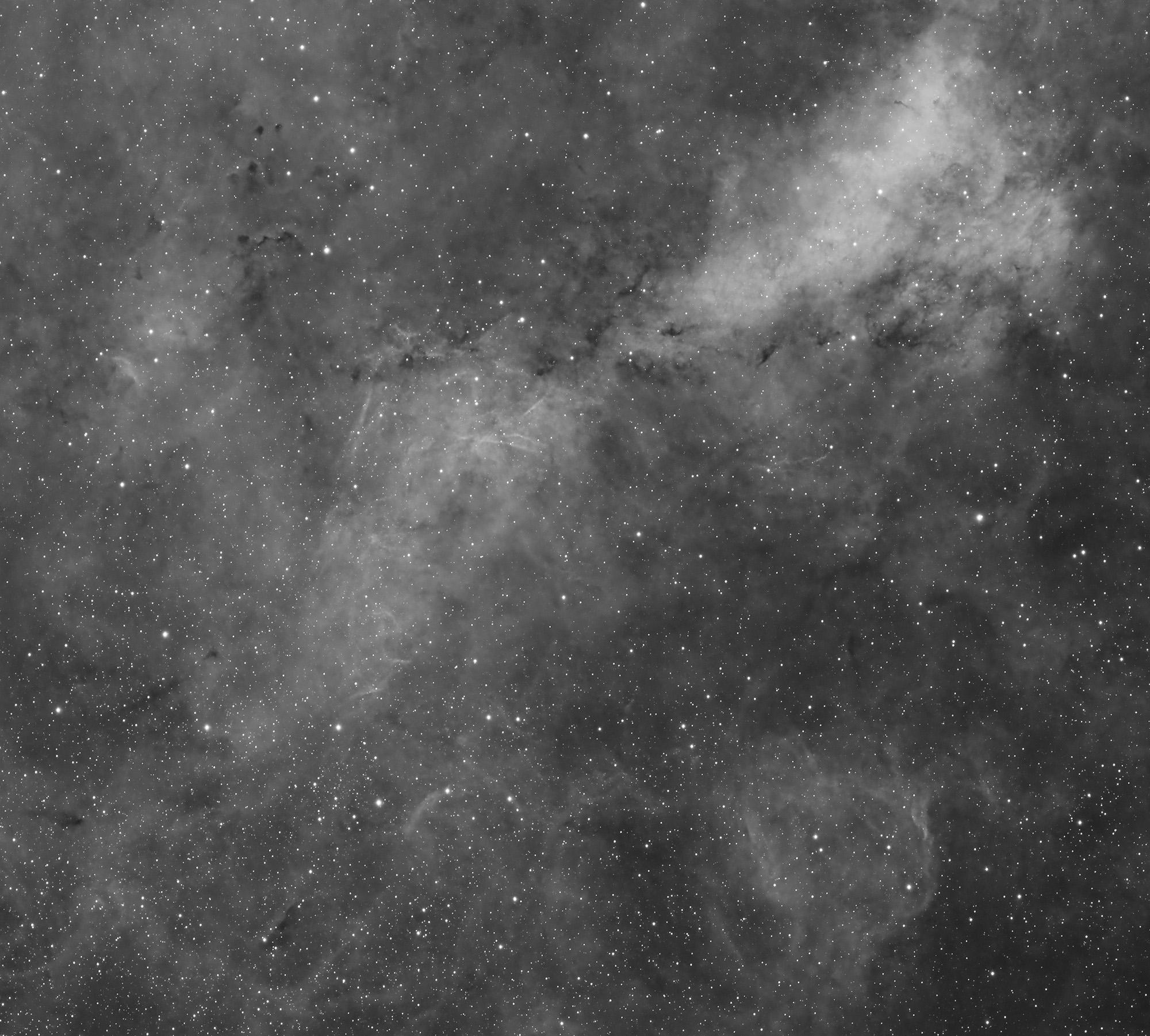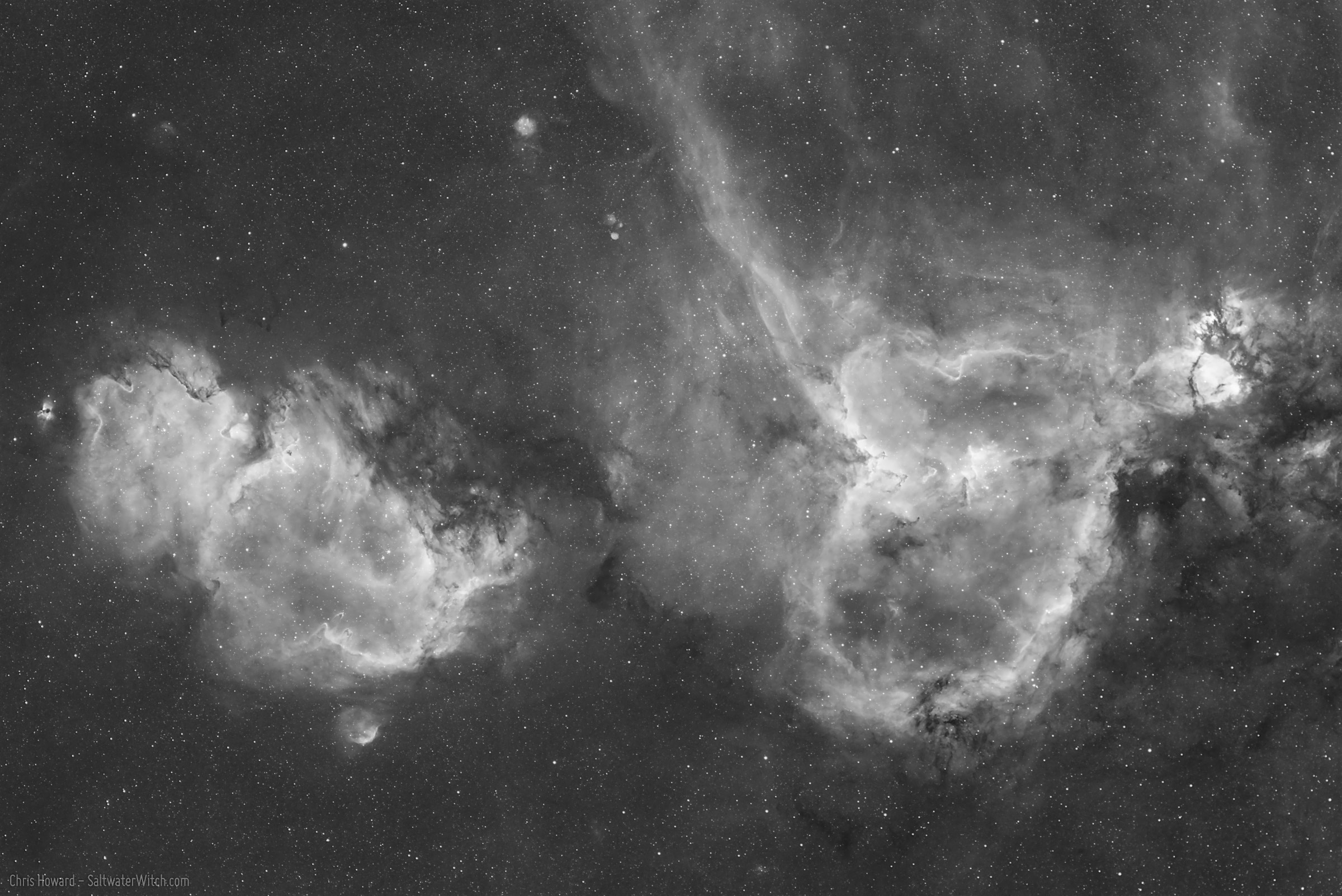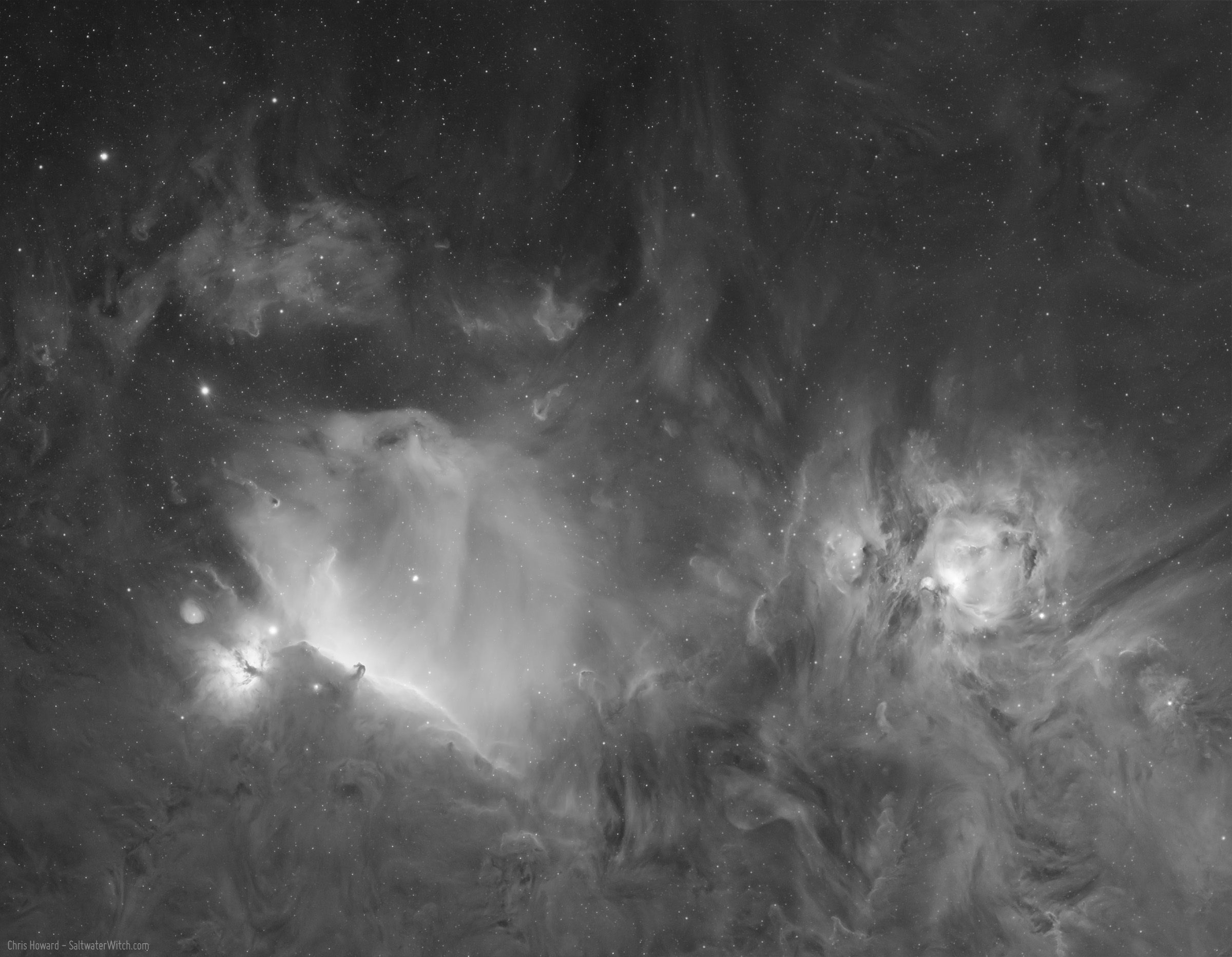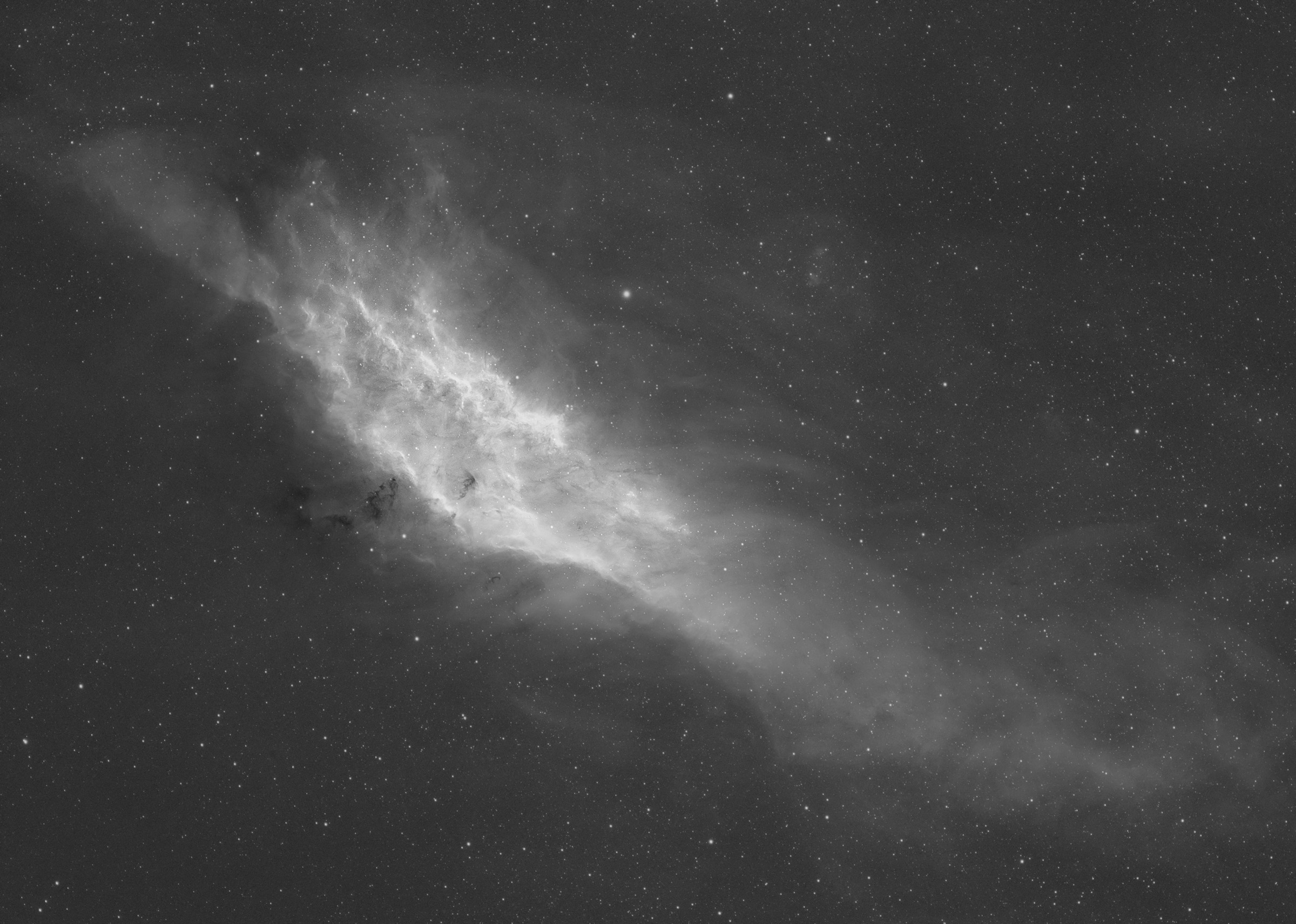Astro Session November 18
Flaming Star Nebula (IC 405, SH 2-229, Caldwell 31) and the Tadpole Nebula (IC 410) in the constellation Auriga, along with the two bright areas of emission toward the bottom, the "Spider and Fly", IC 417 and NGC 1931. 42 x 300-second subs in hydrogen-alpha.

IC 2177, Seagull Nebula region in Ha:

Posted November 19, 2023
Imaging Session 2023-11-16
The Heart Nebula on the right (IC 1805, Sharpless 2-190) and Soul Nebula, left, (Westerhout 5 with the star cluster IC 1848) in Hydrogen-alpha. These two make up a massive star-forming complex in Cassiopeia about 7500 lightyears away in the Perseus Arm of our Galaxy. The bright emission nebula on the far right is the Fishhead Nebula (NGC 896, IC 1795). The small circular cloud, middle top, is another emission nebula Sh2-198, much further away, around 18,000 lightyears (still, well within the galaxy). The bright cluster of stars in the core of the Heart Nebula is Melotte 15.
Imaging Notes: 51 x 5-minute exposures stacked in PI, ZWO ASI2600MM-Pro monochrome camera cooled to -10C, 3nm Antlia Pro Hydrogen-alpha filter, William Optics SpaceCat 51 apo refractor, Sky-Watcher EQ6-R Pro mount. Shot from my backyard in coastal New Hampshire, bortle 4-ish.
Orion Core: two-panel mosaic of Orion's Belt, the Horsehead Nebula, and M42, the Orion Nebula.
Posted November 17, 2023
Astro Session 2023-11-11
Orion’s Belt or the Three Sisters: next time you see that familiar line of three bright stars, the “Orion’s Belt” asterism at the center of the constellation Orion, imagine the backdrop of ionized hydrogen and all the other surrounding stuff you can’t see with your eyes, the bright nebulae, the dark structures of dust and molecular gasses, vast stellar nurseries with violent new stars forming out of trillions of kilometers of hydrogen clouds. There’s so much going on behind these three stars. The center of the Belt, Alnilam, is a single massive star, a supergiant that’s 375,000 times brighter than our star. Alnitak is a triple star system, and Mintaka is a binary star, with the two stars orbiting each other every 5.7 days.
Imaging Notes: 60 x 5-minute exposures stacked in PI, ZWO ASI2600MM-Pro monochrome camera cooled to -10C, 3nm Antlia Pro Hydrogen-alpha filter, William Optics SpaceCat 51 apo refractor, Sky-Watcher EQ6-R Pro mount. Shot from my backyard in coastal New Hampshire, bortle 4-ish.
Our giant neighboring galaxy, Andromeda (M31) in HaRGB. I captured this data last night, waiting for Orion to rise above 30°. Imaging Notes: 30 x 120-second subs in RGB, 30 x 180-second subs in Ha stacked in PI, ZWO ASI2600MM-Pro monochrome camera cooled to -10C, Antlia Pro filters, William Optics SpaceCat 51 apo refractor, Sky-Watcher EQ6-R Pro mount. Shot from my backyard in coastal New Hampshire, bortle 4-ish.
Posted November 12, 2023
Sunday Night Imaging Run
I spent most of the night capturing OIII (Oxygen 3) and SII (Sulfur 2) data in the IC1396 region in Cepheus, enough to combine with last week's Ha (Hydrogen-alpha) data to create a SHO color image, mapping sulfur to red, hydrogen to green, and oxygen to blue in RGB. I've balanced the RGB intensity, but left green for Ha a bit higher. Hydrogen is the most abundant element in the universe—by a very wide margin, and without balancing the Ha, OIII, SII channel values, most nebulae would be overwhelmingly green. That said, I do like to keep more hydrogen green in my images, making them a bit truer to the emission values of most deep sky objects.
I spent the last three hours of the night capturing Ha data of NGC 1499, the California Nebula, about a thousand lightyears away in the constellation Perseus.
Posted October 10, 2023
Pretty good for an 80% moon
From last night’s narrowband imaging run: IC 1396 is a bright HII region over 2000 lightyears away in Cepheus, illuminated and ionized by the very energetic multi-star system HD 206267 (that’s the brightest star in the center of the image). The massive star, top right-ish, is a red supergiant, “the Garnet Star”, μ Cephei (mu Cephei). Mu Cephei is almost 100,000 times brighter than our star, the Sun, and it's over a 1000 times larger. Imaging notes: 61 x 300-second exposures stacked in PixInsight, camera: ZWO ASI2600MM-Pro cooled to -10C, Antlia 3nm Hydrogen-alpha filter. Even with an 80% waning moon, last night turned out well.
Posted October 3, 2023
NGC 7822 in Ha + OIII
Playing around with pixelmath in PixInsight with my narrowband data of NGC 7822, Cederblad 214, an emission nebula in Cepheus, about 3,000 lightyears away. This is Hydrogen-alpha (Ha) combined with Oxygen 3 (OIII) data I captured over several weeks, made up of 52 x 300-second exposures of Ha and 32 x 600-second (10 minute) exposures of OIII. Gear notes: William Optics Space Cat 51 (250mm FL @ f/4.9), ZWO ASI2600MM-Pro monochrome camera cooled to -10C, Sky-Watcher EQ6-R Pro mount, William Optics 32mm/120mm FL guide scope + ZWO ASI290MM-Mini guide camera.
Target Notes: NGC 7822, Cederblad 214, SH2-171 (the brighter emission nebula core) as well as the star cluster Berkeley 59. There are several long chains and clumps of dark nebulae, including LDN 1268, 1275, Dob 3637, 3627, 3623, many more. Nestled in that large band of dark nebulae toward the bottom is the reflection nebula GN 23.56.1. The very small circle of gray at the top left, blending in but dimmer than the nearby stars, with less contrast, is the planetary nebula Abell 1 (PLN 119+6.1). Find all of this—the nebulae and star forming complex in Cepheus near the edge of Cassiopeia.
Posted September 20, 2023
First Light with the ZWO ASI2600MM Pro mono camera
June and July consistently delivered terrible weather for astronomy—here in the northwest US. There was one clear-ish night somewhere in the middle of the waves of thunderstorms, torrential rain, and general cloudiness, but on that one night we were close to a full moon and a few hours of clear skies amid the weeks of cloud that followed that night wasn’t worth the effort. So I waited for the next opportunity. Last night, August 11th, I set up the Sky-Watcher mount (EQ6-R Pro) with the William Optics SpaceCat and my new camera, which I bought in June.
Here's the result of my first imaging run with the ZWO ASI2600MM Pro mono camera, cooled to -10C, Antlia 3nm Hydrogen-alpha Pro Imaging filter (2 inch). 52 x 300-second sub-exposures with minimal calibration (bias & dark, no flat frames). The ASI2600 is built around the monochrome version of the Sony IMX571 APS-C sized sensor, and although you can get away with 36mm unmounted filters, I went all the way to 2 inch mounted narrowband filters. And not even a hint of vignetting. I didn't use flat frames when stacking. So, am I impressed with the ZWO ASI2600MM Pro? Oh yeah.
I started narrowband imaging about ten years ago with Atik mono CCD cameras, moved through a couple QHYs, and settled on the ZWO ASI1600MM Pro—the smaller, older generation of this ASI2600. I've been using the 1600 for four or five years, and it was time to upgrade. The 2600 has been out for a little while—I'm not new to this camera but I'm really glad I made the jump.
Target Notes: NGC 7822, Cederblad 214, SH2-171 (the brighter emission nebula core) as well as the star cluster Berkeley 59. There are several long chains and clumps of dark nebulae, including LDN 1268, 1275, Dob 3637, 3627, 3623, many more. Nestled in that large band of dark nebulae toward the bottom is the reflection nebula GN 23.56.1. The very small circle of gray at the top left, blending in but dimmer than the nearby stars, with less contrast, is the planetary nebula Abell 1 (PLN 119+6.1). Find all of this—the nebulae and star forming complex in Cepheus near the edge of Cassiopeia.
Click for full view:
Posted August 12, 2023
Sadr Region (Northeast)
Sadr Region (Northeast) in Cygnus, with a batch of HII regions and dark nebulae, including IC 1318A, LBN 251, DWB 82 (all refer to the large, bright triangular mass at the top right), scattered lumps of dark nebula, including LDN 894, 892, 891, Dobashi 2429, 2468, 2449, et. al. This is probably it for a little while. We have five or six days of rain storms headed our way, and a waxing moon right along with it.










